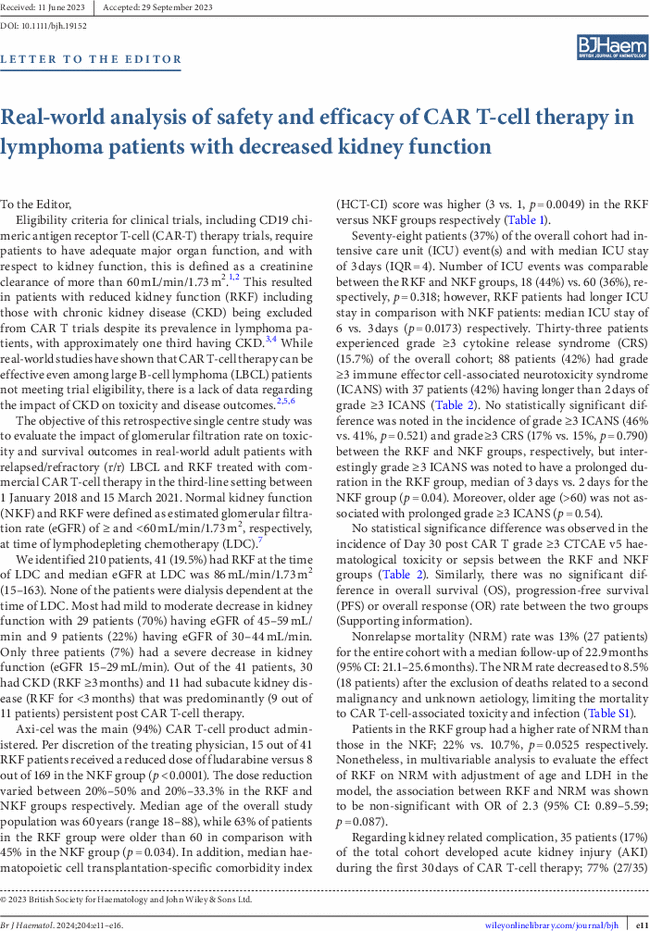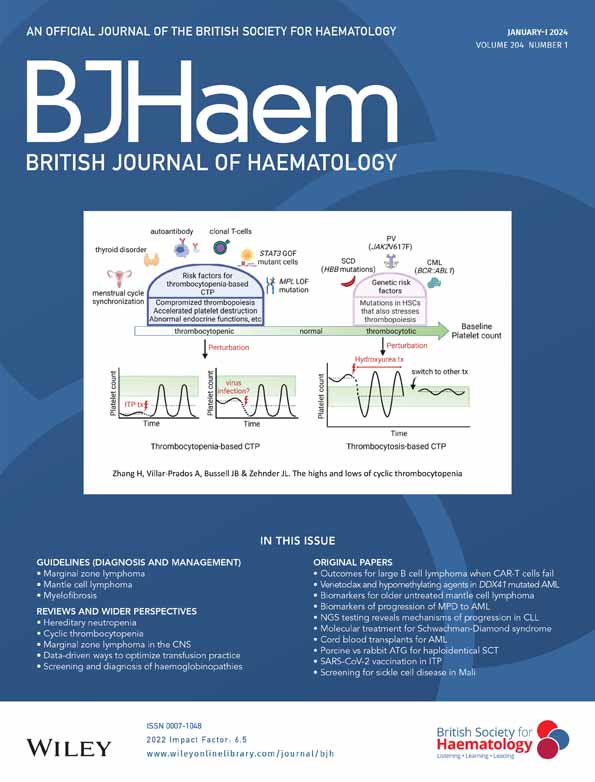Real-world analysis of safety and efficacy of CAR T-cell therapy in lymphoma patients with decreased kidney function
Omar Mamlouk
Section of Nephrology, The University of Texas MD Anderson Cancer Center, Houston, Texas, USA
Search for more papers by this authorPaolo Strati
Department of Lymphoma/Myeloma, The University of Texas MD Anderson Cancer Center, Houston, Texas, USA
Search for more papers by this authorLei Feng
Department of Biostatistics, The University of Texas MD Anderson Cancer Center, Houston, Texas, USA
Search for more papers by this authorRyan Sun
Department of Biostatistics, The University of Texas MD Anderson Cancer Center, Houston, Texas, USA
Search for more papers by this authorAmy Ayers
Department of Lymphoma/Myeloma, The University of Texas MD Anderson Cancer Center, Houston, Texas, USA
Search for more papers by this authorRaphael E. Steiner
Department of Lymphoma/Myeloma, The University of Texas MD Anderson Cancer Center, Houston, Texas, USA
Search for more papers by this authorRanjit Nair
Department of Lymphoma/Myeloma, The University of Texas MD Anderson Cancer Center, Houston, Texas, USA
Search for more papers by this authorChristopher Flowers
Department of Lymphoma/Myeloma, The University of Texas MD Anderson Cancer Center, Houston, Texas, USA
Search for more papers by this authorJeremy L. Ramdial
Department of Stem Cell Transplantation & Cellular Therapy, The University of Texas MD Anderson Cancer Center, Houston, Texas, USA
Search for more papers by this authorNeeraj Saini
Department of Stem Cell Transplantation & Cellular Therapy, The University of Texas MD Anderson Cancer Center, Houston, Texas, USA
Search for more papers by this authorSamer A. Srour
Department of Stem Cell Transplantation & Cellular Therapy, The University of Texas MD Anderson Cancer Center, Houston, Texas, USA
Search for more papers by this authorRichard E. Champlin
Department of Stem Cell Transplantation & Cellular Therapy, The University of Texas MD Anderson Cancer Center, Houston, Texas, USA
Search for more papers by this authorPartow Kebriaei
Department of Stem Cell Transplantation & Cellular Therapy, The University of Texas MD Anderson Cancer Center, Houston, Texas, USA
Search for more papers by this authorLoretta J. Nastoupil
Department of Lymphoma/Myeloma, The University of Texas MD Anderson Cancer Center, Houston, Texas, USA
Search for more papers by this authorMaria A. Rodriguez
Department of Lymphoma/Myeloma, The University of Texas MD Anderson Cancer Center, Houston, Texas, USA
Search for more papers by this authorElizabeth J. Shpall
Department of Stem Cell Transplantation & Cellular Therapy, The University of Texas MD Anderson Cancer Center, Houston, Texas, USA
Search for more papers by this authorYago Nieto
Department of Stem Cell Transplantation & Cellular Therapy, The University of Texas MD Anderson Cancer Center, Houston, Texas, USA
Search for more papers by this authorJason Westin
Department of Lymphoma/Myeloma, The University of Texas MD Anderson Cancer Center, Houston, Texas, USA
Search for more papers by this authorSattva S. Neelapu
Department of Lymphoma/Myeloma, The University of Texas MD Anderson Cancer Center, Houston, Texas, USA
Search for more papers by this authorSreedhar Mandayam
Section of Nephrology, The University of Texas MD Anderson Cancer Center, Houston, Texas, USA
Search for more papers by this authorCorresponding Author
Sairah Ahmed
Department of Lymphoma/Myeloma, The University of Texas MD Anderson Cancer Center, Houston, Texas, USA
Department of Stem Cell Transplantation & Cellular Therapy, The University of Texas MD Anderson Cancer Center, Houston, Texas, USA
Correspondence
Sairah Ahmed, Department of Lymphoma/Myeloma, Division of Cancer Medicine, The University of Texas MD Anderson Cancer Center, Houston, TX, USA.
Email: [email protected]
Search for more papers by this authorOmar Mamlouk
Section of Nephrology, The University of Texas MD Anderson Cancer Center, Houston, Texas, USA
Search for more papers by this authorPaolo Strati
Department of Lymphoma/Myeloma, The University of Texas MD Anderson Cancer Center, Houston, Texas, USA
Search for more papers by this authorLei Feng
Department of Biostatistics, The University of Texas MD Anderson Cancer Center, Houston, Texas, USA
Search for more papers by this authorRyan Sun
Department of Biostatistics, The University of Texas MD Anderson Cancer Center, Houston, Texas, USA
Search for more papers by this authorAmy Ayers
Department of Lymphoma/Myeloma, The University of Texas MD Anderson Cancer Center, Houston, Texas, USA
Search for more papers by this authorRaphael E. Steiner
Department of Lymphoma/Myeloma, The University of Texas MD Anderson Cancer Center, Houston, Texas, USA
Search for more papers by this authorRanjit Nair
Department of Lymphoma/Myeloma, The University of Texas MD Anderson Cancer Center, Houston, Texas, USA
Search for more papers by this authorChristopher Flowers
Department of Lymphoma/Myeloma, The University of Texas MD Anderson Cancer Center, Houston, Texas, USA
Search for more papers by this authorJeremy L. Ramdial
Department of Stem Cell Transplantation & Cellular Therapy, The University of Texas MD Anderson Cancer Center, Houston, Texas, USA
Search for more papers by this authorNeeraj Saini
Department of Stem Cell Transplantation & Cellular Therapy, The University of Texas MD Anderson Cancer Center, Houston, Texas, USA
Search for more papers by this authorSamer A. Srour
Department of Stem Cell Transplantation & Cellular Therapy, The University of Texas MD Anderson Cancer Center, Houston, Texas, USA
Search for more papers by this authorRichard E. Champlin
Department of Stem Cell Transplantation & Cellular Therapy, The University of Texas MD Anderson Cancer Center, Houston, Texas, USA
Search for more papers by this authorPartow Kebriaei
Department of Stem Cell Transplantation & Cellular Therapy, The University of Texas MD Anderson Cancer Center, Houston, Texas, USA
Search for more papers by this authorLoretta J. Nastoupil
Department of Lymphoma/Myeloma, The University of Texas MD Anderson Cancer Center, Houston, Texas, USA
Search for more papers by this authorMaria A. Rodriguez
Department of Lymphoma/Myeloma, The University of Texas MD Anderson Cancer Center, Houston, Texas, USA
Search for more papers by this authorElizabeth J. Shpall
Department of Stem Cell Transplantation & Cellular Therapy, The University of Texas MD Anderson Cancer Center, Houston, Texas, USA
Search for more papers by this authorYago Nieto
Department of Stem Cell Transplantation & Cellular Therapy, The University of Texas MD Anderson Cancer Center, Houston, Texas, USA
Search for more papers by this authorJason Westin
Department of Lymphoma/Myeloma, The University of Texas MD Anderson Cancer Center, Houston, Texas, USA
Search for more papers by this authorSattva S. Neelapu
Department of Lymphoma/Myeloma, The University of Texas MD Anderson Cancer Center, Houston, Texas, USA
Search for more papers by this authorSreedhar Mandayam
Section of Nephrology, The University of Texas MD Anderson Cancer Center, Houston, Texas, USA
Search for more papers by this authorCorresponding Author
Sairah Ahmed
Department of Lymphoma/Myeloma, The University of Texas MD Anderson Cancer Center, Houston, Texas, USA
Department of Stem Cell Transplantation & Cellular Therapy, The University of Texas MD Anderson Cancer Center, Houston, Texas, USA
Correspondence
Sairah Ahmed, Department of Lymphoma/Myeloma, Division of Cancer Medicine, The University of Texas MD Anderson Cancer Center, Houston, TX, USA.
Email: [email protected]
Search for more papers by this author
Open Research
DATA AVAILABILITY STATEMENT
For original data, please contact [email protected].
Supporting Information
| Filename | Description |
|---|---|
| bjh19152-sup-0001-AppendixS1.docxWord 2007 document , 35.2 KB |
Appendix S1. |
Please note: The publisher is not responsible for the content or functionality of any supporting information supplied by the authors. Any queries (other than missing content) should be directed to the corresponding author for the article.
REFERENCES
- 1Kitchlu A, Shapiro J, Amir E, Garg AX, Kim SJ, Wald R, et al. Representation of patients with chronic kidney disease in trials of cancer therapy. JAMA. 2018; 319(23): 2437–2439.
- 2Jacobson CA, Hunter BD, Redd R, Rodig SJ, Chen PH, Wright K, et al. Axicabtagene ciloleucel in the non-trial setting: outcomes and correlates of response, resistance, and toxicity. J Clin Oncol. 2020; 38(27): 3095–3106.
- 3Ubukata M, Hara M, Nishizawa Y, Fujii T, Nitta K, Ohta A. Prevalence and mortality of chronic kidney disease in lymphoma patients: a large retrospective cohort study. Medicine (Baltimore). 2018; 97(2):e9615.
- 4Desai SH, Al-Shbool G, Desale S, Veis J, Malkovska V. Lymphoma survivors have an increased long-term risk of chronic kidney disease. Leuk Lymphoma. 2020; 61(12): 2923–2930.
- 5Nastoupil LJ, Jain MD, Feng L, Spiegel JY, Ghobadi A, Lin Y, et al. Standard-of-care axicabtagene ciloleucel for relapsed or refractory large B-cell lymphoma: results from the US lymphoma CAR T consortium. J Clin Oncol. 2020; 38(27): 3119–3128.
- 6Abramson JS, Palomba ML, Gordon LI, Lunning MA, Wang M, Arnason J, et al. Lisocabtagene maraleucel for patients with relapsed or refractory large B-cell lymphomas (TRANSCEND NHL 001): a multicentre seamless design study. Lancet. 2020; 396(10254): 839–852.
- 7Levey AS, Stevens LA, Schmid CH, Zhang YL, Castro AF III, Feldman HI, et al. A new equation to estimate glomerular filtration rate. Ann Intern Med. 2009; 150(9): 604–612.
- 8Wood AC, Perez AP, Arciola B, Patel K, Johnson G, DiMaggio E, et al. Outcomes of CD19-targeted chimeric antigen receptor T cell therapy for patients with reduced renal function including dialysis. Transplant Cell Ther. 2022; 28(12): 829 e821-829 e828.
10.1016/j.jtct.2022.09.009 Google Scholar
- 9Gutgarts V, Jain T, Zheng J, Maloy MA, Ruiz JD, Pennisi M, et al. Acute kidney injury after CAR-T cell therapy: low incidence and rapid recovery. Biol Blood Marrow Transplant. 2020; 26(6): 1071–1076.
- 10Gupta S, Seethapathy H, Strohbehn IA, Frigault MJ, O'Donnell EK, Jacobson CA, et al. Acute kidney injury and electrolyte abnormalities after chimeric antigen receptor T-cell (CAR-T) therapy for diffuse large B-cell lymphoma. Am J Kidney Dis. 2020; 76(1): 63–71.
- 11Farooqui N, Sy-Go JPT, Miao J, Mehta R, Vaughan LE, Bennani NN, et al. Incidence and risk factors for acute kidney injury after chimeric antigen receptor T-cell therapy. Mayo Clin Proc. 2022; 97(7): 1294–1304.
- 12Ahmed G, Bhasin-Chhabra B, Szabo A, Shah NN, Longo W, Dhakal B, et al. Impact of chronic kidney disease and acute kidney injury on safety and outcomes of CAR T-cell therapy in lymphoma patients. Clin Lymphoma Myeloma Leuk. 2022; 22(11): 863–868.
- 13Dreger P, Holtick U, Subklewe M, von Tresckow B, Ayuk F, Wagner E, et al. Impact of age on outcome of CAR-T cell therapies for large B-cell lymphoma: the GLA/DRST experience. Bone Marrow Transplant. 2022; 58: 229–232.
- 14Jacobson CA, Locke FL, Ma L, Asubonteng J, Hu ZH, Siddiqi T, et al. Real-world evidence of axicabtagene ciloleucel for the treatment of large B cell lymphoma in the United States. Transplant Cell Ther. 2022; 28(9): 581.e1–581.e8.
- 15Michael Scordo JRF, Devlin SM, Gonen M, Parascondola A, Tomas AA, Shouval R, et al. Population pharmacokinetic model identifies an optimal fludarabine exposure for improved outcomes after CD19-directed CAR T cell therapy for aggressive B-NHL: analysis from the cell therapy consortium. 64th ASH Annual Meeting; 2022; New Orleans.
- 16Lichtman SM, Etcubanas E, Budman DR, Eisenberg P, Zervos G, D'Amico P, et al. The pharmacokinetics and pharmacodynamics of fludarabine phosphate in patients with renal impairment: a prospective dose adjustment study. Cancer Invest. 2002; 20(7–8): 904–913.




